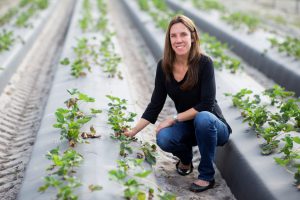Anthracnose fruit rot plagues blueberries, especially in Florida. In fact, it’s among the fruit’s most damaging diseases.
To manage the disease, farmers normally spray the crop with fungicides, but on a calendar basis – in other words, every two or three weeks.
So, a few years ago, University of Florida scientists developed the Blueberry Advisory System, a tool to help blueberry growers fight fruit rot – through a system of alerts.
Now, researchers have proof the system works to help minimize fruit rot and improve crop yields.
When flowers and fruit are developing, many farmers use a calendar-based method to spray their plants to protect against the rot. With the Blueberry Advisory System, they spray when the tool sends them alerts. Notifications are received via text or email.
Growers can also use the risk assessments to choose whether to use a less-expensive fungicide when they encounter moderate disease risk, or a more effective but also more expensive product during high-risk periods.
“Several Florida commercial blueberry growers have reported using the Blueberry Advisory System to help with the timing of fungicides to control anthracnose fruit rot, either by using the web-based tool alone or in combination with farmers’ own spray programs,” said Doug Phillips, UF/IFAS statewide blueberry Extension coordinator.
Clyde Fraisse, a UF/IFAS professor of agricultural and biological engineering, designed the Agroclimate system that hosts this and other disease tools. Natalia Peres, a plant pathology professor at the UF/IFAS Gulf Coast Research and Education Center, adapted and evaluated the disease models used in the system.

Peres outlines the success of the method in a new UF/IFAS Extension document.
“The system can be especially useful in helping newer blueberry growers identify the disease and its dynamics,” Peres said. “It may also reduce the number of fungicide applications, especially when adopted by growers who are risk averse.”
She and her research colleagues assessed the system at nine blueberry farms spread out over Dade City (Pasco County), Fort Lonesome (Hillsborough County) and Labelle (Hendry County).
Results were good. The system notified growers to spray fungicide when fruit rot was more likely to develop, and in most cases, they didn’t need to apply the sprays as often.
Any method that helps fight disease is vital to the efforts of Florida farmers who grow blueberries. The season (from bloom through harvest) runs between December and May and includes about 5,500 acres, with an annual value of $62 million.
Blueberries are most susceptible to fruit rot in warm, wet weather, with temperatures between 59 and 81 degrees. Combine those conditions with 12-hour periods of leaf wetness, and you get ideal conditions for fruit rot to develop.
Data for the fruit rot models used by the system come from the Florida Automated Weather Network, which has weather stations throughout the state.
Rainfall or overhead irrigation can compound the problem by spreading the pathogen to healthy fruit and plants, creating additional opportunities for infection. The pathogen can also be spread by fruits touching each other and from harvesting machinery and sorting equipment.
###
ABOUT UF/IFAS
The mission of the University of Florida Institute of Food and Agricultural Sciences (UF/IFAS) is to develop knowledge relevant to agricultural, human and natural resources and to make that knowledge available to sustain and enhance the quality of human life. With more than a dozen research facilities, 67 county Extension offices, and award-winning students and faculty in the UF College of Agricultural and Life Sciences, UF/IFAS brings science-based solutions to the state’s agricultural and natural resources industries, and all Florida residents.
 0
0
